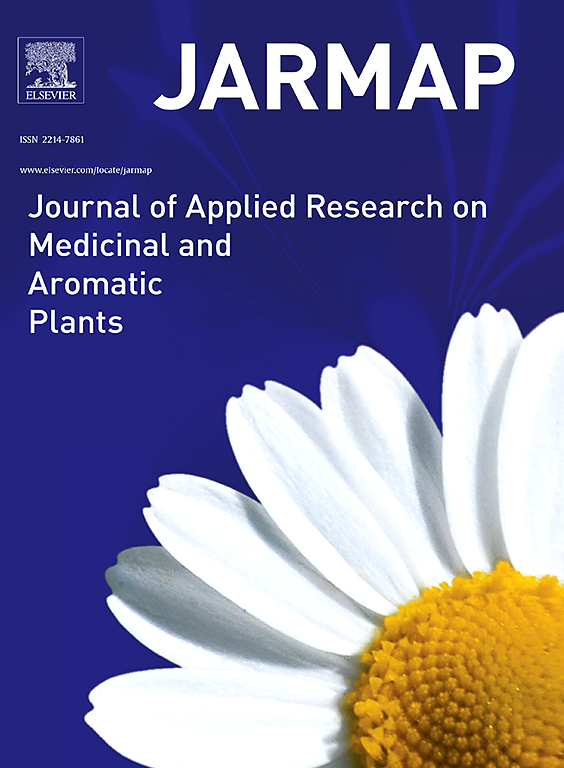用于大规模繁殖芦荟(L. Burm.f.)的高效体外再生方案
IF 3.6
2区 农林科学
Q1 PLANT SCIENCES
Journal of Applied Research on Medicinal and Aromatic Plants
Pub Date : 2024-10-05
DOI:10.1016/j.jarmap.2024.100588
引用次数: 0
摘要
芦荟是一种药用灌木,因其治疗特性而被用于制药和化妆品,但其雄性不育和自交不亲和的特性使得种子繁殖具有挑战性。目前的研究详细介绍了精细的体外再生过程,讨论了直接和间接器官发生技术。在使用多种植物生长调节剂(PGRs)的Murashige和Skoog(MS)培养基中,对嫩枝繁殖、胼胝体形成、胼胝体培养中的器官发生和生根进行了评估。单用 3.5 毫克/升的 BAP(N6-苄基氨基嘌呤)对芽的快速增殖最有效,在直接芽增殖中芽的质量也最健康。研究表明,2.0 毫克/升 Kn(Kinetin)和 1.0 毫克/升 NAA(1-萘乙酸)的组合对胼胝体培养中的再生反应最灵敏,而 2.5 毫克/升 2,4-D(2,4-二氯苯氧乙酸)产生的再生胼胝体最多。此外,体外用 1.5 毫克/升 IBA(吲哚-3-丁酸)处理的小植株生根最多、最长,在随后的适应过程中成活率高达 94%。此外,还简要讨论了通过直接和间接渠道的再生效率。这项研究有望在体外培养的各个阶段提高芦荟大规模生产所需的适当 PGRs 的效率和精确应用。本文章由计算机程序翻译,如有差异,请以英文原文为准。
Efficient in-vitro regeneration protocol for large-scale propagation of Aloe vera (L.) Burm.f.
Aloe vera a medicinal shrub, is used in pharmaceuticals and cosmetics due to its therapeutic properties, but its male sterility and self-incompatibility make seed-based reproduction challenging. The current investigation provides a detailed account of a refined in-vitro regeneration process, discussing direct and indirect organogenesis techniques. Shoot multiplication, callus formation, organogenesis in callus culture, and rooting were all evaluated in the Murashige and Skoog (MS) medium employing several plant growth regulators (PGRs). BAP (N6-benzyl amino purine) alone at 3.5 mg/l was the most effective treatment for rapid shoot multiplication and the healthiest shoot quality in direct shoot proliferation. It was shown that a combination of 2.0 mg/l Kn (Kinetin) and 1.0 mg/l NAA (1-naphthalene acetic acid) was most responsive for regeneration in callus culture, whereas 2.5 mg/l 2,4-D (2,4-dichloro phenoxy acetic acid) produced the most profuse regenerative callusing. In addition, plantlets treated with 1.5 mg/l IBA (indole-3-butyric acid) in-vitro produced the highest and longest roots, contributing to a 94 % survival rate during the subsequent acclimatization process. Moreover, regeneration efficiency via direct and indirect channels is also briefly discussed. This research has the potential to enhance the efficiency, precise application of appropriate PGRs needed for the mass production of Aloe vera at various stages of in-vitro culture.
求助全文
通过发布文献求助,成功后即可免费获取论文全文。
去求助
来源期刊

Journal of Applied Research on Medicinal and Aromatic Plants
Pharmacology, Toxicology and Pharmaceutics-Drug Discovery
CiteScore
6.40
自引率
7.70%
发文量
80
审稿时长
41 days
期刊介绍:
JARMAP is a peer reviewed and multidisciplinary communication platform, covering all aspects of the raw material supply chain of medicinal and aromatic plants. JARMAP aims to improve production of tailor made commodities by addressing the various requirements of manufacturers of herbal medicines, herbal teas, seasoning herbs, food and feed supplements and cosmetics. JARMAP covers research on genetic resources, breeding, wild-collection, domestication, propagation, cultivation, phytopathology and plant protection, mechanization, conservation, processing, quality assurance, analytics and economics. JARMAP publishes reviews, original research articles and short communications related to research.
 求助内容:
求助内容: 应助结果提醒方式:
应助结果提醒方式:


